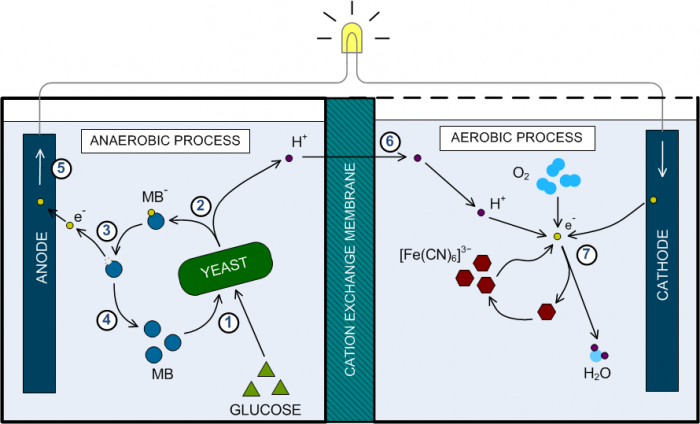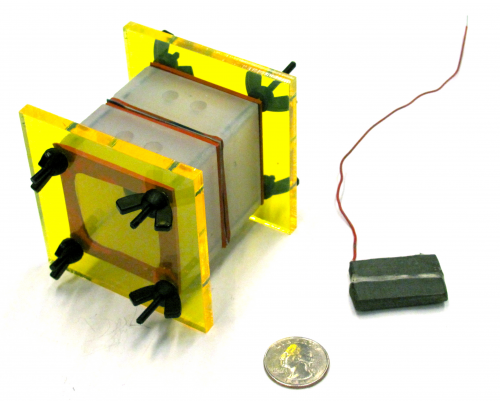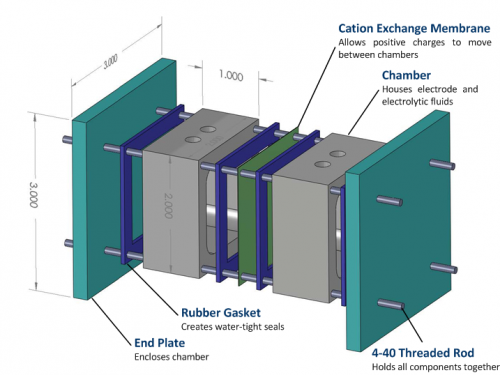Microbial Fuel Cells (MFCs): Open Source Educational Kit
This project was created by Andrew Leader (EE'13) and Stefania Samojlik (ME'13) from The Cooper Union for the Advancement in Science and Art.
Edited: 04-30-2013
PROJECT DESCRIPTION IN 75 WORDS OR LESS...
We have developed an educational microbial fuel cell kit for high school students. The kit enables students to perform experiments that relate theory to measured results, illustrate the relationship between biology and engineering, and increase their interest in STEM fields. We are testing the kit in the classroom to refine directions for construction, a sample lesson plan, and a sample lab protocol. These materials are made available on the internet for public use.
INTRODUCTION TO MFCS
Microbial fuel cells (or MFCs) are a type of fuel cell that uses the natural metabolic processes in microbes to convert chemical energy into electrical energy. The specific model used in this educational kit is the Saccharomyces cerevisiae/methylene blue anode and a potassium ferricyanide/oxygen cathode MFC with glucose as the fuel. These specific MFC reagents were chosen on their safety and availability in the classroom. The MSDS sheets for the reagents can be found here. The steps of the MFC processes are described in the figure and text below.
1. The microbe takes in fuel (glucose) and the mediator molecule (methylene blue, MB), and digests the glucose. During this process, an electron (e-) binds to the mediator molecule.
2. The microbe excretes the negatively-charged MB and a proton (H+) into the surrounding fluid.
3. An electron is transferred from MB to the anode.
4. MB is recycled.
5. The electron travels from the anode to the cathode across a load.
6. Meanwhile, a proton diffuses across the cation exchange membrane to the cathode chamber.
7. The proton, oxygen, electron and ferricyanide ([Fe(CN)6-]3+) react to form water. The ferricyanide is recycled.
For a more detailed explanation of the biological and chemical processes, see introduction_to_mfcs.pdf.
CONSTRUCTING A MFC
Each MFC consists of the following manufactured components:
- 2 end plates (drawing: endplate_drawing.pdf)
- 2 chambers (drawing: chamber_drawing_1.pdf)
- 4 rubber gaskets (drawing: gasket_drawing.pdf)
- 2 graphite electrodes
Other readily available components include:
- 4 threaded rods
- 8 wing nuts
- 1 cation exchange membrane
The full bill of materials can be found here: mfc_materials.pdf
The manufacturing instructions for the components can be found here : <insert pdf here>
MFC Solution Recipes
anode solution cathode solution phosphate buffer solution
videos:
SAMPLE LESSON HANDOUT
The lesson plan handout contains all teacher preparation material and student handouts for an introductory lesson on electricity and MFC experimentation. This lesson does not assume any prior knowledge of electricity.
ANOTHER LESSON IDEA: MAXIMIZING POWER OUTPUT
This suggested lesson plan is suitable for students learning about electricity on a high school level. The experiment deals with impedance matching and power maximization within a nonlinear system such as the MFC. The following is a brief procedure and sample data from such an experiment:
power_maximization_procedure.pdf
sample_data.pdf
OLD STUFF:
Project Proposal: project_proposal.pdf
MFC Diagram: visio-mfc_diagram.pdf
MFC Prototype: mfc_prototype_solidworks_exploded_view.pdf
Interim Powerpoint Presentation: presentation_mfc.pdf
Fourth (and Final) Draft of Poster :fall_poster_ver4.pdf


